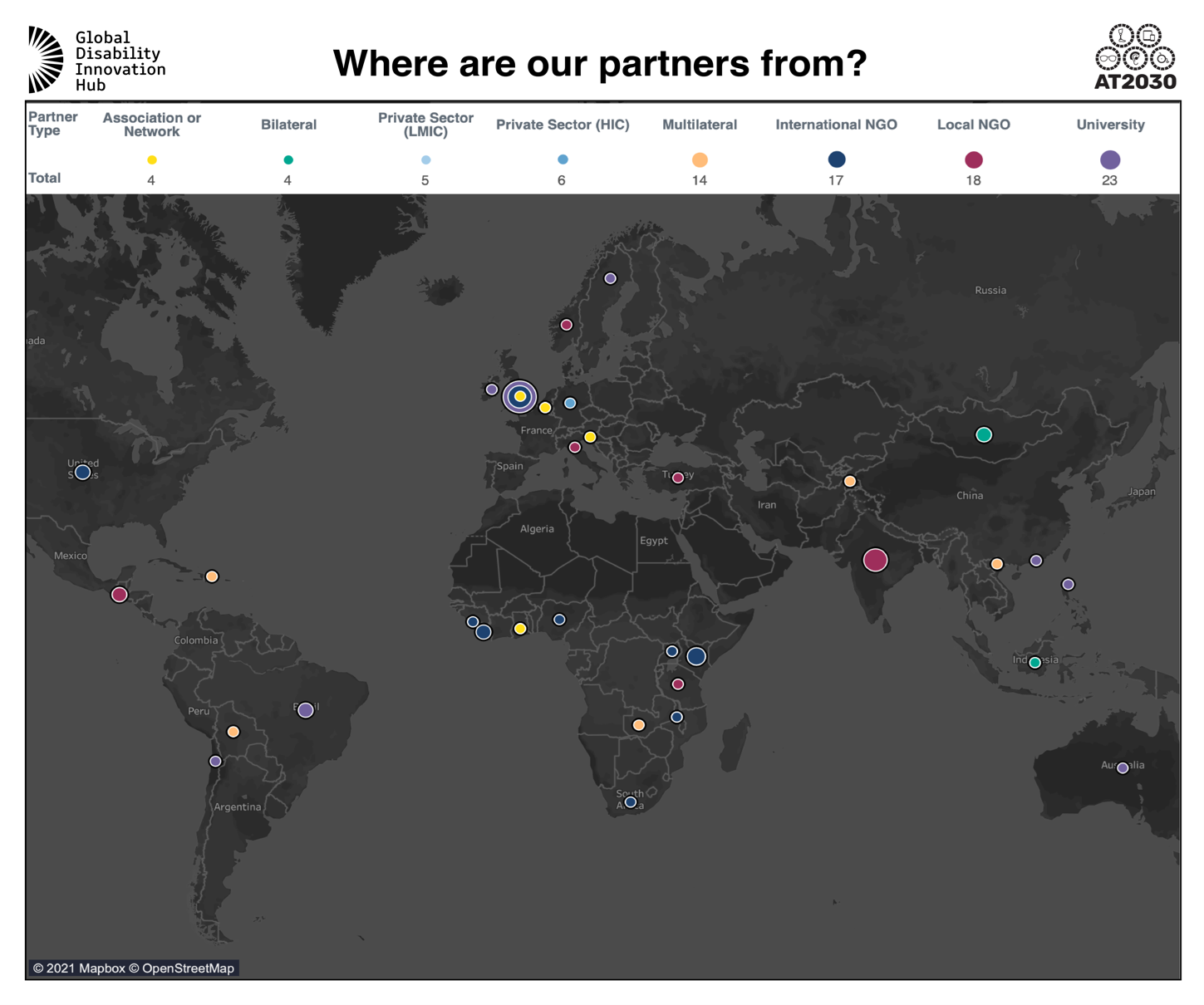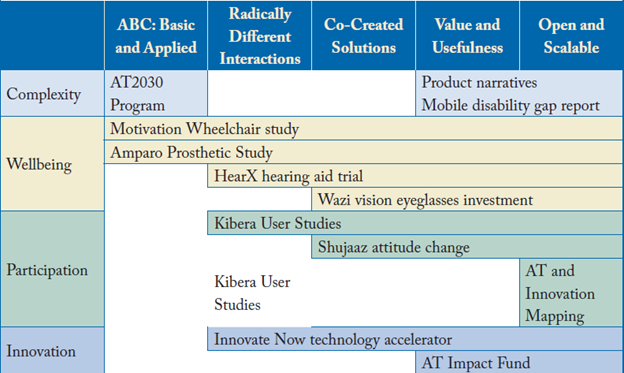Case Study: DIX within the AT2030 program in Kenya
We now take a look at how a DIX approach has played out in accessibility research and assistive technology research within the AT2030 program [135]. Throughout this program we strive to incorporate all the elements of a new approach to DIX research. This is not to say of course that the program itself is perfect, as it is of course not the case, but its large portfolio of activities contains all the ingredients to test the DIX manifesto and develop new solutions and theories, in keeping with the ABC approach to research of Shneiderman which forms one of our core DIX Principles.
AT2030
AT2030 is a £19.8m program of research funded by the UK’s Foreign, Commonwealth & Development Office (FCDO). It was launched at the Global Disability Summit in London in 2018. The GDS was a significant event where world leaders convened to make pledges for disability inclusion. The UK Government co-hosted the event with the Government of Kenya, and our AT2030 program had been co-designed over 4 months leading up to the Summit. The program is global – it operates in 35 countries and contains over 50 partnerships, with a focus on East Africa and Kenya in particular (see Figure 12). The number and type of partners changes as the program evolves. As part of the AT2030 program GDI Hub has, in Kenya, partnered with the GSMA, CHAI, the Government of Kenya, and local Kenyan-based charities including Kilimanjaro blind Trust and Motivation Wheelchairs. For example, the Clinton Health Access Initiative supports the Government of Kenya in developing policy, whilst GDI Hub helps scope the innovation landscape. Other partners such as AMREF Enterprises deliver the GDI Hub powered Innovate Now accelerator, which works with local partner Kilimanjaro Blind Trust Association to deliver the Live Labs network. The growth of AT2030 happened from additional funding from FCDO as well as nearly £10m in matched funding from partners big and small linking into and amplifying the reach and impact of the program. Cross-sectorial partnerships have been key to this approach.

Figure 3.11: Map showing the location of all the partners of the AT2030 program.
A number of projects which form the large portfolio of the AT2030 program have been conducted in Kenya, some of these are fully contained within the country, whereas some others are part of a wider multi-country or global study. These projects include:
- Landscaping studies for mobile phone access and access to digital and physical assistive products;
- Working with the Government of Kenya to develop a wheelchair provision plan, a mapping of AT provision and innovation spaces across Kenya and a country capacity assessment to understand where systems need strengthening;
- Local research within an informal settlement in Nairobi with people with mobility and vision impairments on the role of mobile and physical assistive products in enabling access;
- A campaign and research study with Shujazz a local magazine which reaches over 50% of Kenyan youth to understand attitudes towards people with disabilities and look to use behavior change methods to help shift attitudes towards greater inclusion and positivity;
- An innovation accelerator for start-ups which has seen 16 ventures supported through a bespoke designed inclusive entrepreneur toolkit; and
- Three pre-clinical trials of technology (a hearing screening tool and aid, an in-part 3D printed wheelchair and a new prosthetic service that leverages thermoplastic materials. In the case of the hearing aid the mobile-based screening tool and hearing aid the innovation being trialed are not just at technological level, but they include a new financing model to test affordability of solution at a local level.
A mapping of these projects of the AT2030 program against the dimensions and principles of DIX is given in Table 2. All projects encompass each of the DIX principles, however, some are more strongly associated with some principles than others, and within the table this is demonstrated.
The wicked nature of disability inclusion is acknowledged within the country capacity assessment work and the product narratives which act as sort of landscaping studies for why markets are broken globally and what actions can be taken to help shaping them into more functioning markets. An opportunity for better wheelchair provision services came out of this work which has been developed with local stakeholders including Motivation Wheelchairs. This raised awareness within governments and with the work completed to understand the role of new technological approaches to product design and service delivery as well as the innovation accelerator helped to develop the AT innovation map of Nairobi which is housed on the www.innovationAction.org site.
This mapping was completed alongside work to understand the markets for assistive products and also the disability mobile gap [151]. The former completed in partnership with the Clinton Health Access Initiative (CHAI) (see wheelchair [20] Prostheses [21], Eyeglasses [22] , Digital [19]and Hearing Aids[23] , and the latter with GSMA). The research which informed the reports has also been analyzed more deeply and detailed individual studies have been published in a wide range of venues [30]. These more detailed insights have led to new grant proposals for basic research.
We also conducted a number of user studies around the use of different types of ATs. Initially these were in two main areas: Kibera, an informal settlement where we investigated the role of mobile in enabling opportunity and access for people with mobility and visual impairments; and the second in clinical settings where we tested and assessed new products and services for wheelchair users and prosthetic users.
Table 3.2: Example of AT2030 research across the DIX principles and across the DIX dimensions. All projects strive to encompass each of the DIX principles. However, some are more strongly associated with some principles than others, and within the table this is demonstrated.

The studies in Kibera are further unpacked in terms of their research findings in Chapter 4. Here, we briefly touch on two things, the capacity building work, and the links between basic and applied research. As mentioned above, in capacity building we adopted a handover approach to research with the local community, hiring and training local Kiberan residents to be part of the research teams, including authoring teams . This partnership, facilitated through the Kilimanjaro Blind Trust (KBT), has continued and led to further collaboration on different projects. For example, KBT has developed a pipeline of research testing for innovators within the innovate now (www.innovatenow.org) technology accelerator.
This close partnership on applied research—testing new products and understanding user needs in the wild—alongside another partnership in India with IIT Delhi, has exposed the chronic need for children with disabilities in low-and middle-income countries (LMICs) to have better access to tools which enable STEM education. This has led to new basic research into shape memory alloys for a new tactile array which allows children who are visually impaired to draw, and to explore graphs and charts as well as shapes and geometries [45].
Finally, we reach the work to change attitudes towards people with disabilities and assistive technology users more broadly. Through the partnership with Shujaaz we co-designed story lines for a local magazine using focus groups of local youth across Kenya. Thanks to multimodal engagement with young people with and without disabilities, we gathered baseline evidence and then ran a campaign showing people with disabilities simply integrated into story lines, without a focus on their impairment or AT. Al the reports for the multidisciplinary work carried out by different institutions can be found on the AT2030 website (www.at2030.org).
This case study was excerpted from Disability Interactions: Creating Inclusive Innovations by Catherine Holloway and Giulia Barbareschi, https://doi.org/10.1007/978-3-031-03759-7, pages 109–111.